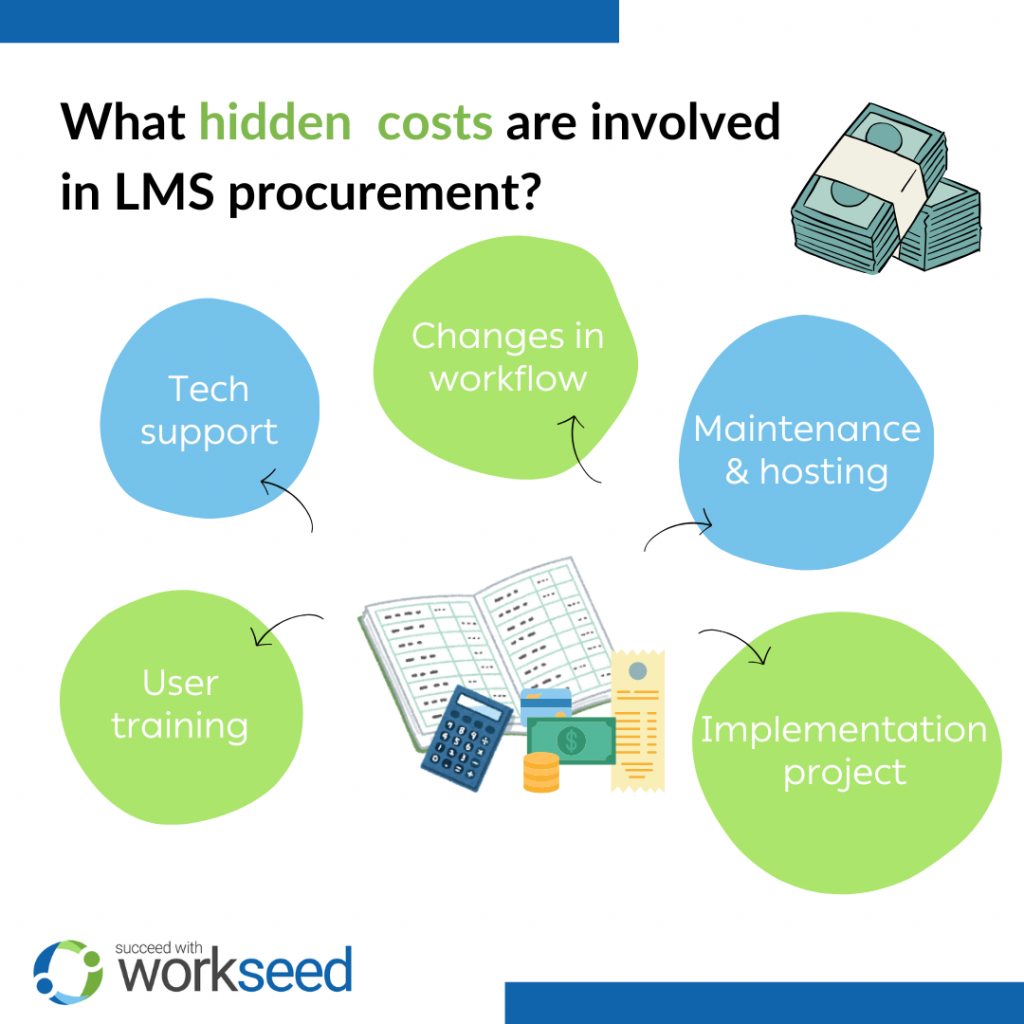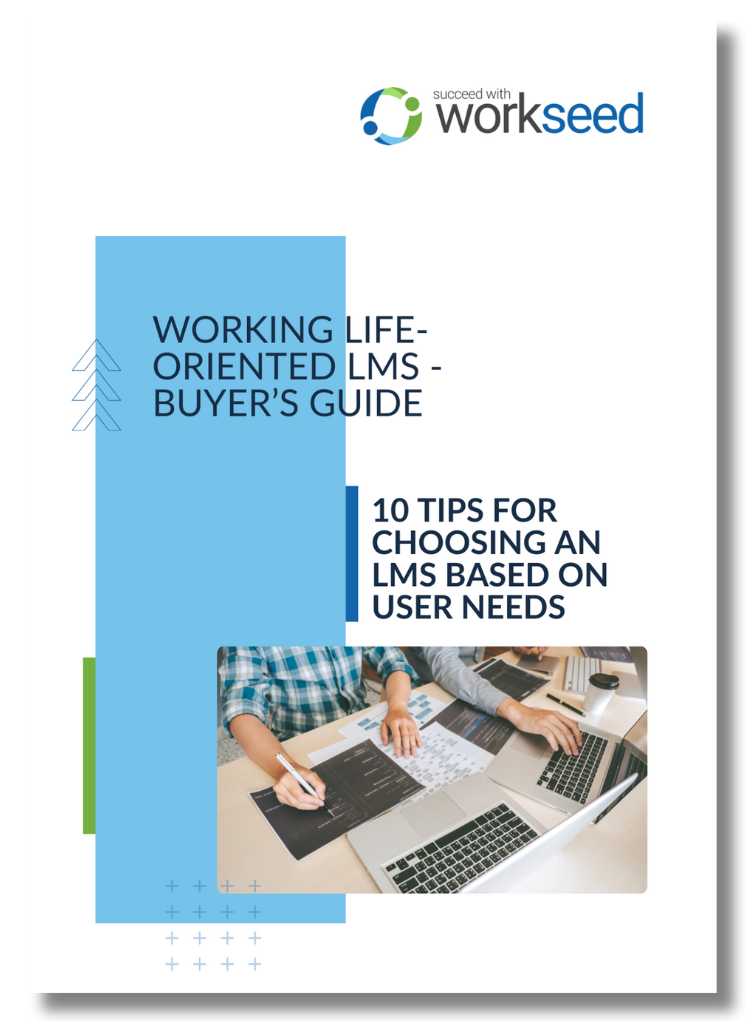The price tag of an LMS may be misleading.
There are often hidden costs that may be difficult to factor in when comparing software products like LMSs. Hidden costs may emerge indirectly or later during the software life cycle, or be related to maintenance or use of the software solution.
Total cost of ownership can constitute a useful paradigm to understand what the use of a software solution actually costs. This makes it easier to identify hidden costs and plan a transparent budget.
What are the hidden costs of a learning management system?
When comparing learning management systems (LMS), it is easy to focus exclusively on the value of the purchase, annual license, or the implementation project. At the same time, costs caused by daily use or changes in workflow may be difficult to factor in.
This will likely cause surprises in the long term. A badly planned acquisition can cause unexpected costs and problems long after implementation. That is why long-term planning is essential for a successful software procurement.
Hidden costs can include:
Indirect salary costs. It is very common to only include the direct salary costs of project members and system admins when planning for implementation. In reality, implementation of a new learning management tool likely impacts many people across departments. Management may contribute to planning, regular users may spend time providing insight into their needs, hosting and user training may require time from the IT department.
Training and tech support. Users will need training and technical support throughout the learning management systems life cycle. It is tempting to only consider the costs of user training during the implementation project and underestimate the need for long-term user support.
Technical maintenance and hosting. It is very easy to underestimate how much time and money needs to be spent on maintaining learning management systems. Particularly open source tools can be surprisingly expensive to maintain, particularly if the organization decides to self-host the management system. Regular updates, data safety processes, and solving technical problems will require resources.
Initial configuration. Few software tools can really be implemented without any adjustments. At the very least the learning management system settings must be configured for the specific organization. It may be necessary to also implement integrations to other data systems. At worst, some components must be custom designed for specific use cases.
Changes in the workflow. Acquiring a new learning management system will invariably impact how work is done within an organization. New tools imply changes in an organization’s workflow, which requires adaptation. Insufficient preparation and support for users can lead to underused tools and low productivity.

Total cost of ownership as a paradigm for LMS procurement
The total cost of ownership is a useful paradigm for understanding software procurement. It is based on a broad definition of costs, going beyond the purchase price, annual license, or any other short-term measurements. Rather, it requires acquisition planning to factor in all indirect and long-term costs during the entire life cycle of the solution.
The value of total cost of ownership lies in its ability to provide a holistic view on the costs of a software tool and identify indirect and hidden costs. It provides tools for avoiding nasty surprises later on.
A successful learning management system procurement includes the following elements:
Supplier’s services and users’ needs resonate. When planning for a procurement, it is important to first understand the needs of the buyer organization and users. It is also important to understand what processes can and should be managed in-house, and what should be outsourced. Only then is it possible to compare potential providers and understand how well they can meet the needs.
Does the organization have the resources to host an open source learning management system, or would a cloud-based tool be more flexible? Should the system be customized to a very specific use case, or is it possible to save money by purchasing a ready-made software tool? What kind of integrations are needed? What would be the most effective way to provide user training and tech support?
Management engagement to implementation. Implementing a new learning management system can be a complex process that requires sufficient planning. A badly managed and planned implementation project will likely fail to meet its budget and deadlines. Insufficient support will likely lead to under-utilization of the system and low productivity.
It is important to have management support and an engaged project team to see over the implementation. It is easier to succeed when everyone understands the value of the new learning management system, the organization chooses a system that meets its needs, the implementation project has sufficient resources, and project members are committed to the project.
All users are consulted when implementation is planned. Software procurement should not happen in a silo. All the direct and indirect users, not only system admins and IT, should be involved in the acquisition project from the beginning. Consulting a broad range of users the project team will have a better and richer understanding of user needs and use cases, and can choose more relevant LMS providers for comparison.
Consulting end-users and meeting their needs also makes it easier to implement the new learning management system to the day-to-day workflow. Better adoption means higher use rate, less waste, and easier change management.
Sufficient resources for adapting to reality. Providing sufficient resources for the implementation guarantees resiliency. Costs involved in a learning management system procurement can be not only indirect, but also unexpected.
The implementation project team can never be prepared for every possible externality. New use cases, user requirements, extra work, or unexpected hurdles can always emerge when the project is already underway. The most important thing is the ability to respond to changing requirements. The project team needs enough resources and autonomy to respond to surprises.
Workseed – a flexible SaaS learning management system
The Workseed learning management system is provided as a turnkey solution. Workseed is a cloud-based SaaS solution whose lifetime cost is easy to predict.
The licensing fee includes hosting and all technical maintenance. We make sure that personal data is always stored and processed safely and legally. We also make sure the information security of the LMS is up to sufficient standards.
Our experts can help your organization plan and execute the implementation project. We also provide services pertaining to user training to make sure the new system is adopted as smoothly as possible.
For example Laurea University of Applied Sciences implemented the Workseed LMS for internship management in record time. The ambitious implementation project was the culmination of a broad procurement process.
The project was a success – mostly due to an engaged project team, sufficient support from the provider, and extensive user training.
You can read the entire customer story here.
In case you want to hear more about Workseed features and how we can support during the implementation, you can book a demo with our experts here.














